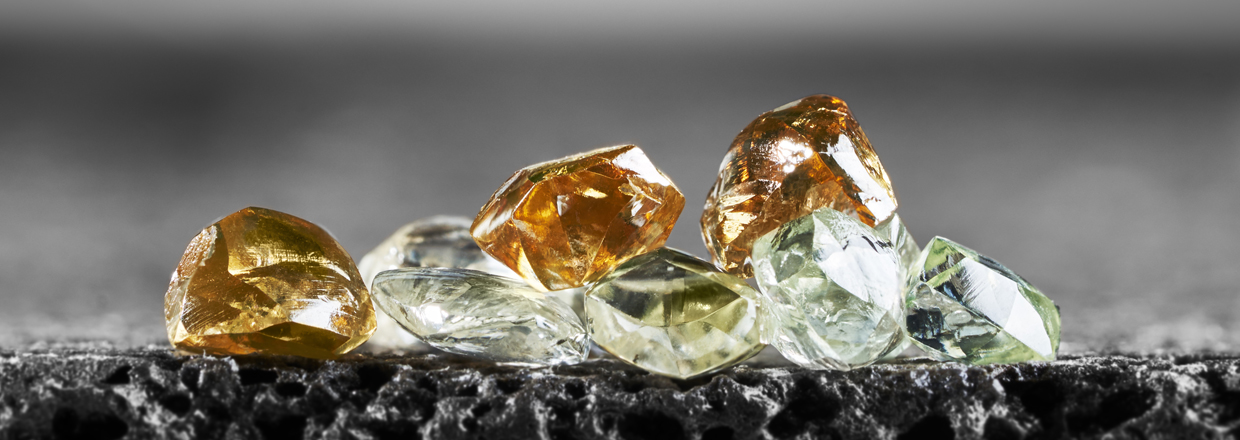If we say the world diamond,
what would be your 1st thought ?
When we hear the word "diamond," a myriad of images flood our minds: sparkling, white, flawless... But what if we told you there's a world beyond the conventional, a world where diamonds don't just shimmer in shades of white, but dance in a symphony of warm, inviting hues?
In a previous post, we delved into the raw, untamed beauty of uncut diamonds. Now, let's embark on a journey into the mesmerizing world of Champagne Diamonds, where each gem tells a story of elegance, warmth, and undeniable allure.

Are all the diamonds white ?
In the glittering world of gemstones, diamonds reign supreme as symbols of timeless elegance, enduring love, and unparalleled beauty. Yet, there exists a prevailing perception that most diamonds are pristine, colorless gems, radiating pure white light with every facet. This perception, deeply ingrained in popular culture and fueled by centuries of tradition and marketing, has long shaped the collective consciousness surrounding diamonds.
The Gemological Institute of America (GIA) classifies diamonds into two main categories: "colourless" diamonds, which are graded based on the absence of color, and fancy color diamonds, which encompass a spectrum of hues beyond traditional white diamonds, including captivating shades like champagne, pink, and blue.
What sets fancy colour diamonds apart is their rarity. While colorless diamonds are valued for their absence of color, fancy color diamonds derive their value from the presence and intensity of their hues. Their rarity is determined by the scarcity of diamonds with natural, vivid colors, making them highly coveted by collectors and connoisseurs alike.
The 7 C’s of champagne diamonds
Champagne diamonds, with their warm and inviting hues, possess a unique charm that sets them apart in the world of fancy color diamonds. When evaluating champagne diamonds, gemologists and consumers alike consider the 7 Cs Color Definitions: C1 - C7. The 7 C’s of Champagne diamonds Color Grading, should not be mistaken for the 4C’s of Diamond Basic : Carat , Color, Clarity , Cut as described in details here : 4C´s of Diamond
*some grade 8 Cs – the number 8 grading color overlaps with Fancy Cognac Color Nuance
The most distinctive feature of champagne diamonds is their enchanting range of warm, earthy tones. The color of a champagne diamond can vary from light champagne to deep cognac, with shades encompassing delicate hints of gold, amber, and brown. The argyle mine in Australia has established a grading scale going from C1 to C7.
Gemologists evaluate champagne diamonds based on the intensity, saturation, and uniformity of their colour. They also take into account te hue, the saturation and the tone. A champagne diamond with a rich, even coloration commands greater value and desirability.
Unique Champagne Diamond Color Grading Definition C1-C7
Normally, diamond colors are defined on a scale from D to Z, where D represents colorless and Z a slight yellow hue. Yet Champagne diamonds have a separate diamond color grading technic. Diamond Laboratories will only describe, in the certificates they issue, a Champagne diamond as yellowish brown or fancy light yellow-brown. But, the Argyle Mine has set up their own diamond grading system for these specific fancy color diamonds, which ranges from C1 to C7, where C1 is a light champagne color and C7 a dark color close to Cognac Color diamonds. We need however to remember that this Color grading scheme can only be used as an approximate reference, as nature creates Champagne Diamonds in endless beautiful variations.

Cut: The cut of a champagne diamond plays a crucial role in enhancing its beauty and maximizing its sparkle. The precision and craftsmanship of the cut determine how effectively light interacts with the diamond, resulting in its brilliance, fire, and scintillation. Unlike colorless diamonds, the reflection of Champagne diamonds is less pronounced. Therefore, it`s important to take into account the impact of the cut quality on the colour intensity, in order to optimise their unique colour properties, enhancing their warmth and radiance.
Where are champagne diamonds coming from ?
The majority of Champagne diamonds originate from the Argyle Diamond Mine*, located in the remote East Kimberley region of Western Australia. The Argyle mine has been one of the world´s largest producers of Champagne diamonds, as well as pink diamonds and other colored diamonds, since it began operations in the early 1980s. In addition to the Argyle Diamond Mine, Champagne diamonds are also found in other diamond-producing regions around the world, including Brazil, Russia, Africa, and Canada. However, the Argyle mine has been particularly renowned for its production of Champagne diamonds, contributing significantly to their availability in the global market.
The geological conditions in this region have played a significant role in the formation of Champagne diamonds. Over millions of years, volcanic activity and geological processes have brought diamonds closer to the Earth´s surface, where they can be mined. The unique combination of geological factors, including the presence of specific minerals and the right temperature and pressure conditions, has resulted in the formation of Champagne diamonds with their warm, golden-brown hues.
*It´s important to note that the Argyle Diamond Mine ceased operations in 2020, marking the end of an era for Champagne diamond production. As a result, Champagne diamonds from the Argyle mine are expected to become increasingly rare and valuable in the future, further enhancing their allure and appeal to collectors and jewellery enthusiasts worldwide.

Champagne Diamonds through the centuries
Champagne diamonds have a rich history dating back to ancient civilizations, where they were revered for their rarity and natural beauty. In ancient India, diamonds, including coloured varieties like champagne diamonds, held spiritual significance and adorned ceremonial artefacts as symbols of wealth and status.
During the Renaissance period, diamonds experienced a resurgence in popularity among European nobility, with colored diamonds, including champagne tones, favored for their elegance and individuality.
 |
In the modern era, champagne diamonds have regained popularity, thanks to discoveries in diamond-producing regions like Australia. The Argyle diamond mine, renowned for its production of pink diamonds, also yielded an abundance of champagne diamonds, elevating their status globally. Today, champagne diamonds continue to captivate with their timeless elegance, versatility, and warm tones, adorning jewellery pieces and symbolizing enduring love and celebration. At Hirsch Jewellery we adore them on a wedding ring.
To conclude throughout the centuries, champagne diamonds have transcended time and trends, leaving an indelible mark on the world of fine jewellery. From ancient civilizations to modern-day connoisseurs, these exquisite gemstones have captivated hearts and minds with their warm, inviting hues and timeless allure. As we journey through the centuries, champagne diamonds will continue to shine as symbols of elegance, refinement, and enduring beauty, captivating generations to come.
 |
Discover our selection of champagne diamond
